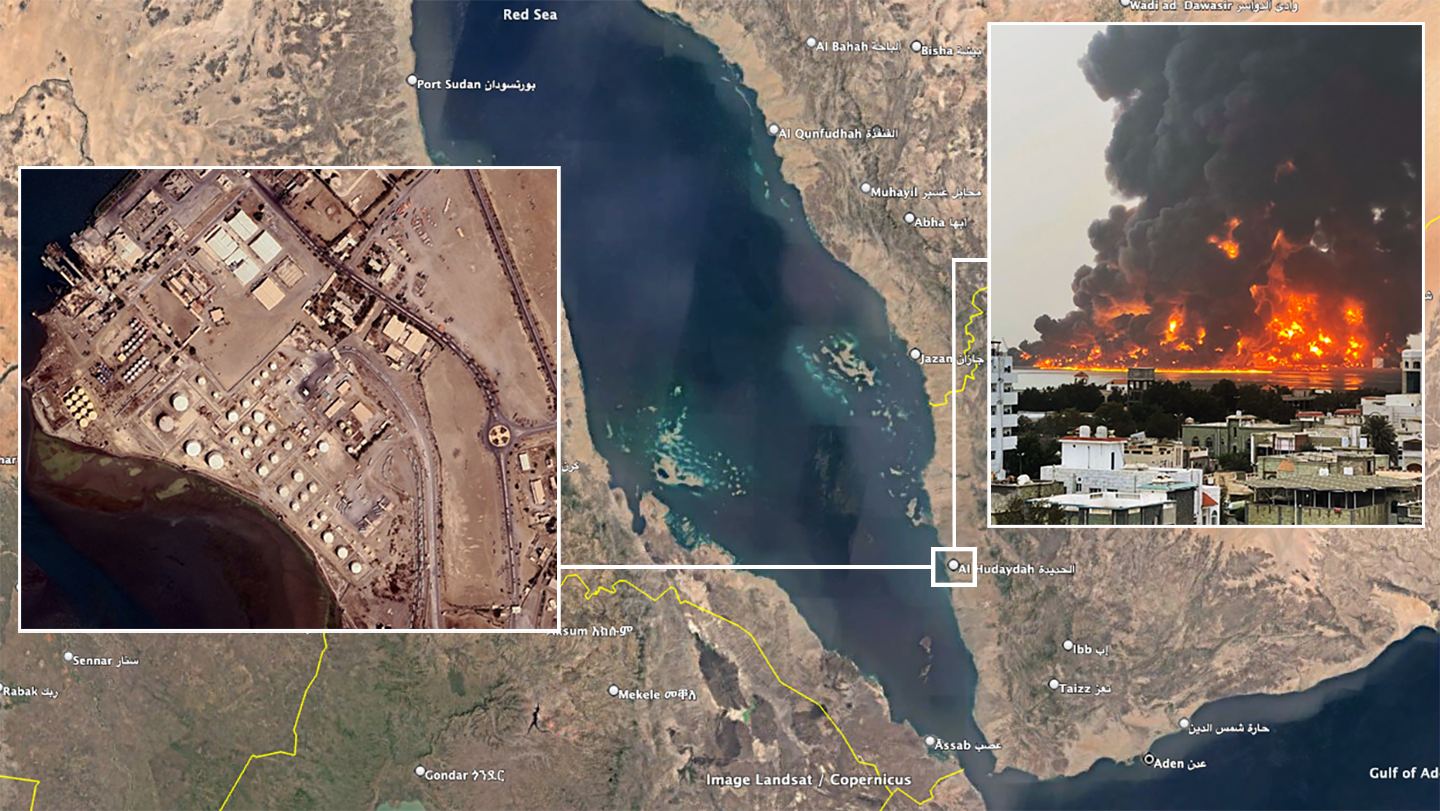The Israeli Air Force carried out a long-distance strike on an oil depot in the Houthi-controlled city of al-Hudaydah in western Yemen.
“A short while ago, IDF fighter jets struck military targets of the Houthi terrorist regime in the area of the Al Hudaydah Port in Yemen in response to the hundreds of attacks carried out against the State of Israel in recent months,” the IDF said on Telegram. “There are no changes in the Home Front Command defensive guidelines. In the case of a change to the guidelines, we will update the public accordingly. Details to follow.”
The attack, Israel’s first on Yemen and at least 1,250 miles away over the shortest route, comes one day after the Iranian-backed group carried out their first lethal strike on Tel Aviv in Israel, prompting officials there to say that targeting Yemen “was on the table.”
Dramatic video and images are emerging on social media showing massive flames erupting in the wake of that attack. The fuel storage site was clearly a very valuable target based the the size of the resulting fire alone.
There was also video purporting to show an Israeli Air Force 707 aerial refueling tanker and an F-35I, as well as other fighters, flying over Eilat towards the Red Sea.
If the most direct route through international airspace was taken, this would be the longest Israeli air strike since Operation Wooden Leg, the 1985 attack on the Palestine Liberation Organization (PLO) headquarters in the Tunisian capital of Tunis. That attack saw Israeli F-15A/B ‘Baz’ fighters acting in the strike role fly at least 1,400 miles to their target. A strike on a facility in Khartoum in 2012 was nearly as far as the one on Yemen.
Regardless, the strike is a clear reminder of Israel’s long-range strike capabilities, which have been honed via real operations spanning decades and constant practice to execute a major air campaign against Iranian nuclear interests. It isn’t clear if these were direct strikes or some kind of standoff weaponry was used, but considering the very low-level air defense capabilities of the Houthis, it was likely at least a semi-direct attack using JDAMs or similar weaponry.
The strike on Yemen also marks the end of Israeli patience with regard to the Houthis.
Since October, when the Israel-Hamas war broke out sparking Houthi attacks in support of Palestinians, there have been many long-range drone, cruise and ballistic missile attacks on Israel. The vast majority of these failed or were intercepted by U.S. warships and aircraft or Israeli defenses.
The attack comes as Israel is still bogged down in the Gaza fight and could be aiming to launch an invasion into Lebanon after repeated cross-border missile, rocket and drone attacks by Hezbollah.
Nasruddin Amer, a Houthi spokesman, said a response by the group was “inevitable,” according to the New York Times.
“Our country is at war with the enemy Zionist entity and it will not stop its operations in support of Gaza,” he wrote on social media. “Rather, it will escalate the operations.”
As Friday’s attack on Tel Aviv – which killed one person and injured at least 10 shows – they have the ability to carry out long-distance attacks on Israel.
This is a developing story.
Update: 1:40 PM Eastern –
The IDF released video and images show its F-15 Baz fighters preparing to attack the Houthis in Yemen and recovering after the mission. Interestingly, no stores are shown, aside from a covered one of the Baz’s centerline station, which could be a Ophir reconnaissance pod. We only see Elta ELM-3222 self escort electronic warfare pods on the landing jet which are standard fit for Israeli F-15A/B/C/Ds.
The Israelis are calling this attack Operation Long Arm.
A spokesman for the White House National Security Council said the U.S. was not involved in the strike and did not “coordinate or assist the Israelis with the strikes.”
The Houthis will soon release a statement.
Update: 2 PM Eastern –
Mohammed Al-Bukhaiti, a member of the Houthi political bureau, released a statement:
“The Israeli aggression against Yemen will not stop our military operations in support of the Palestinian people. Rather, they will increase until the aggression against Gaza is stopped and the siege on its residents is lifted, and we will meet escalation with escalation.”
Update: 3 PM Eastern –
Israel released a video of Prime Minister Binyamin Netanyahu in the Air Force command center during the attack.
Rear Adm. Daniel Hagari, the IDF spokesman, issued a statement.
The Houthis have also issued a statement.
Update: 4:39 PM Eastern –
Residents of the southern Israeli city of Eilat reported hearing explosions while video has emerged on social media claiming to show Israeli air defenses activated there.
“Eilat residents reported late Saturday that interceptors were activated in the city and sounds of explosions could be heard in the area,” the Israeli YNet News outlet reported.
“The reports regarding explosions heard in the area of Eilat are under review,” the IDF said on Telegram.
U.S. Central Command said it destroyed a Houthi drone over the Red Sea in the past 24 hours.
Update: 5 PM Eastern –
The IDF issued an update on Eilat:
“A short while ago, reports were received regarding explosions heard in the area of Eilat. It was found that no projectiles were fired toward the area of the city and no interceptor was launched. There is no indication of a security incident.”
Contact the author: howard@thewarzone.com
